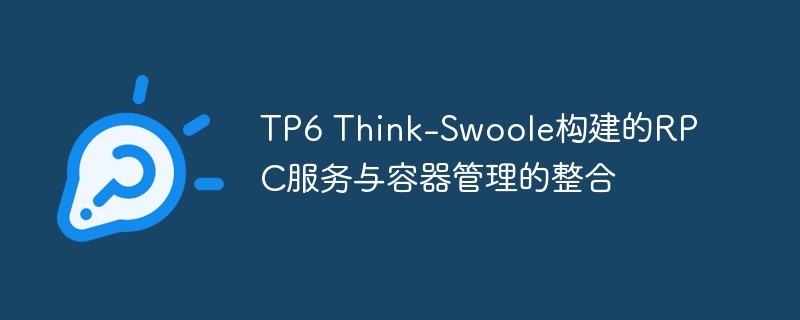

TP6 The integration of RPC services and container management built by Think-Swoole requires specific code examples
1. Introduction
With the rapid development of the Internet As development progresses, the design and construction of distributed systems becomes increasingly important. RPC (Remote Procedure Call) is a commonly used distributed communication mechanism that can realize communication and data interaction between different computer nodes. Container management is an important tool for managing and scheduling various components and services in distributed systems.
In the TP6 framework, Think-Swoole is a high-performance Swoole extension that can be used with container management tools to quickly build high-performance RPC services. This article will introduce how to integrate RPC services in TP6 Think-Swoole and integrate it with container management.
2. Construction of RPC service
First, we need to create a server to receive and process remote call requests. In the TP6 framework, we can use Think-Swoole to create a server based on the TCP protocol. The following is a simple example:
use thinkswooleServer; $server = new Server('tcp://0.0.0.0:9501'); $server->set([ 'worker_num' => 4, 'task_worker_num' => 2, ]); $server->onRequest(function ($request, $response) { // 处理RPC请求 }); $server->start();
In the above code, we created a server of the TCP protocol and set the number of worker processes and the number of task processes. Then, a callback function is defined through theonRequestmethod to handle the received RPC request.
In the callback function, we can use the container management tool to create an RPC service and call the corresponding method to process the request. The following is a simple example:
use thinkRpcServer; use apppcExampleService; $server = new Server(); $server->register(ExampleService::class, function () { return new ExampleService(); }); $server->onRequest(function ($request, $response) use ($server) { // 提取请求参数 $service = $request['service']; $method = $request['method']; $params = $request['params']; // 调用RPC服务 $result = $server->call($service, $method, $params); // 将结果返回给客户端 $response->end($result); }); $server->start();
In the above code, we registered an RPC serviceExampleServicethrough theregistermethod and fetched the request in the callback function Parameters, the corresponding RPC service method is called, and the result is finally returned to the client.
3. Integration of container management
In the TP6 framework, we can use container management tools to manage and schedule various components and services. The following is a simple example:
First, we need to create a container object to manage and schedule various components and services. In the TP6 framework, we can create a container object through theappfunction:
use thinkContainer; $container = Container::getInstance();
Then, we can use the # of the container object ##bindMethod to register components and services. The following is a simple example:
$container->bind('example', 'app\Example');
example, and the corresponding implementation class isappExample.
$server->onRequest(function ($request, $response) use ($server, $container) { // 提取请求参数 $service = $request['service']; $method = $request['method']; $params = $request['params']; // 获取RPC服务实例 $serviceInstance = $container->make($service); // 调用RPC服务方法 $result = call_user_func_array([$serviceInstance, $method], $params); // 将结果返回给客户端 $response->end($result); });
makemethod of the container object, and then call the corresponding RPC through dynamic invocation Service method.
The above is the detailed content of TP6 Integration of RPC services and container management built by Think-Swoole. For more information, please follow other related articles on the PHP Chinese website!




